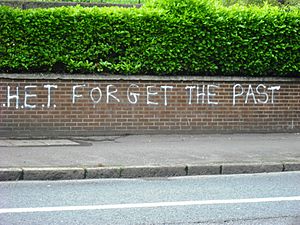Historical Enquiries Team facts for kids
The Historical Enquiries Team (HET) was a special group within the Police Service of Northern Ireland (PSNI). It was started in September 2005. Its main job was to look into 3,269 unsolved deaths that happened during a time of conflict called the Troubles. This period was between 1968 and 1998. The HET finished its work in September 2014. This happened when the PSNI changed its structure due to money cuts.
Contents
What Was the Historical Enquiries Team?
The Historical Enquiries Team was a police unit. It focused on old cases from the Troubles. These were cases where people had died. The HET wanted to find out what really happened.
Why Was the HET Created?
The HET had three main goals when it was set up:
- To work closely with the families of those who had died.
- To make sure all investigations met modern police standards.
- To do their work in a way that everyone in the community could trust.
Working with families was very important to the HET. They had a special process to support families. The HET promised to give each family a copy of their investigation report.
Who Led the HET?
The team was led by Commander David Cox. He used to work for the London Metropolitan Police. The HET had about 100 investigators and support staff. They also had a budget of £30 million.
How Did the HET Work?
The HET was divided into two main parts:
- Review Team: This team had police officers from outside Northern Ireland. They looked over old cases.
- Investigation Team: This team was hired locally. They carried out new investigations.
The HET hoped to finish its work by 2011. However, they realized they needed more time. They worked through the cases in the order they happened. In the past, military witnesses were often interviewed by military police. This raised questions about how fair those early interviews were.
In September 2014, the PSNI made big changes. This led to the HET closing down. A smaller unit within the PSNI took over its work.
What Did the HET Find Out?
The HET investigated many important cases from the Troubles. They helped to clarify what happened in these events.
Key Investigations and Discoveries
- Terry Herdman (1973): Terry was 17 when he died. Some people thought he was giving secrets to the army or police. The HET found that he was not knowingly an informer.
- Miami Showband killings (1975): This was an attack on a music band's minibus. The HET confirmed that a leader of a group called the UVF was involved. They also found that this leader was secretly working for the police. The HET said this raised "worrying questions" about secret cooperation between armed groups and state forces.
- Kingsmill massacre (1976): This was an attack on a minibus carrying civilians. The HET reported that the group responsible included members of the Provisional IRA. This was even though the IRA was supposed to be on a ceasefire. The HET found that the 10 men who died were targeted because they were from the Protestant community. This attack was a response to other killings that happened the night before.
- Aidan McAnespie (1988): Aidan was shot by a British soldier. The soldier said his gun went off by accident. The HET report said this was the "least likely" explanation for what happened.
- Damien Walsh (1993): Damien was 17 when he died while working. The HET reported that undercover British soldiers were watching. They saw members of a group called the UFF attack Damien. The soldiers were too far away to stop it.
- William McGreanery (1971): William was shot by a British soldier in Derry. The HET found that he was not carrying a weapon. He was not a threat to the soldiers. This was different from earlier claims.
- Majella O'Hare (1976): Majella was a young girl. She was shot in the back by a bullet. The HET report supported an earlier police investigation. It found that the British soldier who shot her was not shooting back at anyone, as he had claimed.
- Reavey Brothers (1976): Three Catholic brothers were shot in their home. The HET report cleared them and their family of any links to armed groups.
- Sean Graham bookmakers' shooting (1992): Five Catholic civilians died in a shooting at a shop. The HET confirmed that one of the guns used by the UDA group had been given back to them by police officers before the attack.
Review of the HET's Work
In 2013, a report looked at how the HET was doing its job. This report was from the UK's Her Majesty's Inspectorate of Constabulary. It found that the HET was not always reviewing all cases in the same way. It also found that cases involving deaths caused by police or military members were sometimes looked at "with less care" than other cases.


